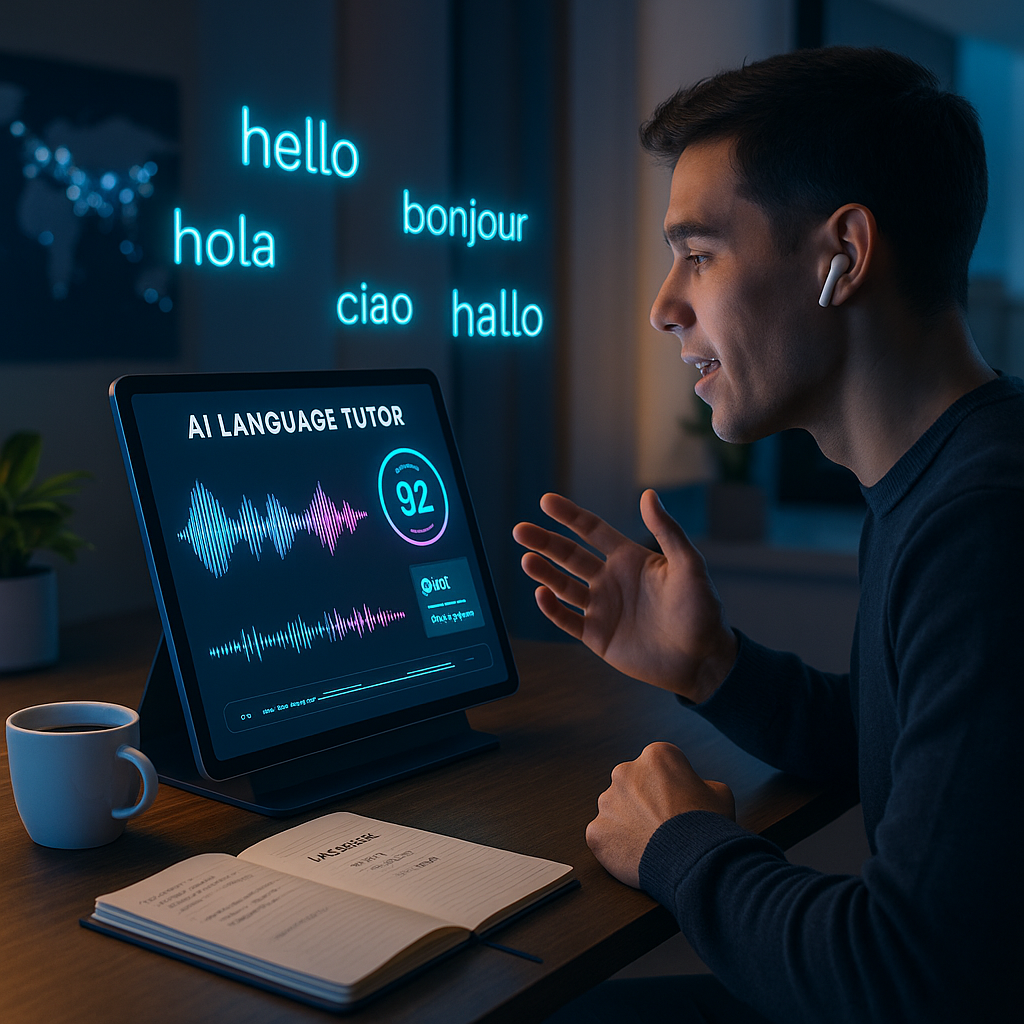Key Takeaways
-
Speak fearlessly: AI creates a safe space for mistakes: Unlike interactions with human tutors or peers that might trigger performance anxiety, AI language companions foster a judgment-free environment where mistakes are not only tolerated but encouraged for growth. Learners can experiment boldly, building fluency without fear of embarrassment or criticism.
-
Real conversations, real progress: With advanced speech recognition, AI tutors engage learners in dynamic, unscripted dialogues that closely mimic real-world exchanges across a variety of everyday and professional scenarios. This interactive approach helps break the monotony of rote memorization, accelerating the path to true communicative competence.
-
Instant feedback sharpens speaking skills: AI-powered language learning apps analyze pronunciation, grammar, and even intonation in real time. Filtered through individualized learning profiles, these platforms deliver actionable, personalized feedback that far outpaces the slow correction cycles of traditional self-study or group courses.
-
24/7 native-speaker access on demand: Conversational AI makes native-like practice instantly available at any hour. No scheduling conflicts, no missed appointments, and no geographic limitations mean spoken language mastery becomes more accessible, inclusive, and adaptable to every lifestyle.
-
Crosstalk and unsupervised methods unlock true fluency: Some sophisticated tools employ the crosstalk method, where AI navigates and adapts to multilingual input in real time. This stretches learners beyond textbook dialogues, fostering robust comprehension and flexibility needed for complex, real-life linguistic environments.
-
AI complements, not replaces, human tutors: Machines cannot replicate the full emotional nuance or mentorship of a devoted teacher. Nonetheless, AI provides relentless, consistent practice and confidence-building, serving as a tireless ally that prepares learners for richer, more meaningful interactions both inside and beyond the classroom.
If you have ever dreaded the spotlight of classroom recitations or yearned for a patient, unfaltering language partner, the current wave of AI offers a gateway to lively, risk-free exploration. Let’s examine how these digital minds are revolutionizing the journey toward genuine linguistic connection.
Introduction
For many, practicing a new language feels more like rehearsing lines on a stage than engaging in natural conversation. That is, until they meet an AI capable of listening, responding, and turning every mistake into momentum. Language learning AI is shattering the confines of stilted flashcards and formulaic scripts, empowering learners through smartphones that transform into ever-available conversation partners, ready to engage in authentic, unscripted dialogue any time.
At the heart of this evolution lies advanced speech recognition technology, which brings interactive, real-time feedback and personalized guidance to every session. Each error becomes a learning opportunity, each interaction sharpens skills, and each moment spent with AI builds courage and confidence. Let’s take a closer look at how these innovative tools are opening new paths to fearless fluency and genuine connection. All of this, without the burden of the classroom spotlight.
The Evolution of AI Speech Recognition in Language Learning
The realm of language education has been fundamentally reshaped by the emergence of AI-powered speech recognition. Modern language platforms no longer rely solely on simplistic pattern matching but embrace the intricate sophistication of neural networks capable of understanding not only the words spoken but their context, accent, and subtle nuances.
Stay Sharp. Stay Ahead.
Join our Telegram Channel for exclusive content, real insights,
engage with us and other members and get access to
insider updates, early news and top insights.
 Join the Channel
Join the Channel
Today’s AI interprets speech through a labyrinth of algorithms attuned to diverse accents, regional dialects, and even speech impediments. This ensures that feedback isn’t generic, but refined, targeted, and increasingly personalized with every session. For example, an English learner from Brazil might receive distinctly different feedback than one from Germany, reflecting background-specific pronunciation challenges and learning patterns.
The most advanced systems go further. They identify errors that even native speakers might overlook—for instance, subtle issues in intonation or contextual meaning. This leads to a more deliberate and effective path to fluency.
Importantly, these technological advances are being leveraged not just in language education, but in other sectors as well. In healthcare, AI-powered speech recognition facilitates accurate medical dictation and triaging for patients with diverse language backgrounds. Finance industry professionals use similar tools to improve global client communication. Educational institutions deploy AI to support multilingual classrooms, improving accessibility for students from non-dominant language backgrounds. This underlines AI’s broad transformative impact across domains.
Real-Time Feedback and Pronunciation Mastery
Instant Pronunciation Analysis
AI-powered systems dissect each utterance into its most granular elements (phonemes), allowing learners to grasp complex features like stress, rhythm, and intonation. Through immediate, session-by-session analysis, learners spot and correct issues on the fly. That’s a stark contrast to the delayed feedback of traditional methods.
This real-time insight not only speeds up the learning process but also nurtures self-awareness. Learners begin to notice their own patterns and adjust organically, building a solid foundation for lifelong language acquisition.
Personalized Correction Pathways
AI’s ability to chart individualized journeys stands at the forefront of its teaching power. By tracking a learner’s native language and unique challenges, the system delivers problem sets and pronunciation drills tailored to maximize progress. For example, Japanese learners of English can zero in on the challenge of distinguishing ‘l’ and ‘r’ sounds, while Mandarin speakers might focus on word stress placement (a common barrier to natural speech rhythm).
This bespoke approach parallels the adaptive strategies now being harnessed in business and customer service. AI-powered call centers, for instance, use similar feedback loops to train multilingual agents, ensuring nuanced pronunciation and context sensitivity in global interactions.
Adaptive Learning and Progress Tracking
AI systems closely monitor every aspect of a learner’s growth, from vocabulary retention and grammatical accuracy to fluid conversational prowess. By maintaining a holistic, multidimensional progress map, AI dynamically recalibrates lesson difficulty, pacing, and content selection to keep learners constantly engaged. Never overwhelmed or unchallenged.
This adaptability isn’t limited to vocabulary and grammar; it includes genre shifts, practical scenarios, and the integration of cultural cues. For instance, a learner who excels at travel-related dialogues might be steered toward business negotiation roleplays, expanding capabilities and confidence alike.
Such adaptability is mirrored in fields beyond language learning. In finance, for example, AI models personalize investor education and risk profiling. In education more broadly, adaptive online courses tailor content to learner needs for improved outcomes. This cross-industry versatility signals the growing importance of responsive, individualized digital education tools.
Speak Fearlessly: Building Confidence Through AI Practice
Creating a Judgment-Free Environment
AI’s infinite patience and impartiality dissolve the barriers of self-consciousness that so often plague language learners. There is no rolling of eyes, no interruption, only space to try, fail, learn, and improve (free from human scrutiny).
This sense of psychological safety is fundamental for forging true fluency. Learners who perceive an environment as safe are naturally more willing to speak, make mistakes, and experiment. These behaviors are essential to progressing beyond basic memorization into creative, authentic communication.
real-time AI feedback loops not only support technical mastery but also cultivate the adaptive mindset that underpins effective communication.
Overcoming Speaking Anxiety
Graduated exposure, orchestrated by AI’s intelligent scaffolding, means learners can start with manageable phrases and steadily advance to complex, spontaneous conversations. By tailoring challenge and support to the unique anxiety triggers of each user, AI catalyzes breakthroughs in both confidence and competence.
Research and user testimonials increasingly show reduced performance anxiety and greater motivation among those who incorporate AI conversation into their study routines. This model has also influenced approaches in therapeutic and healthcare settings. For instance, AI-driven social robotics can help individuals practice social skills in judgment-free environments.
Natural Conversation Simulation
Context-Aware Dialogues
Sophisticated AI language tutors engage learners with context-sensitive, flowing conversations that replicate the unpredictable nature of real-life exchanges. These systems remember details, reference previous responses, and adapt to evolving topics. The result? A tapestry of dialogue that feels genuinely human.
Stay Sharp. Stay Ahead.
Join our Telegram Channel for exclusive content, real insights,
engage with us and other members and get access to
insider updates, early news and top insights.
 Join the Channel
Join the Channel
Such contextual mastery not only enhances engagement but also prepares learners for real-world situations, where conversations seldom follow a script. The outcome is a boost in conversational agility—being able to think and respond in the moment, rather than searching for memorized replies.
learning dynamics between humans and AI emphasize how digital conversation partners can function as both tutors and creative sparring partners.
Dynamic Response Generation
Innovation extends to AI’s ability to represent different personalities, tones, and emotional states, exposing the learner to the diversity of communication styles they will encounter in the world. Some platforms allow users to select practice partners modeled after various backgrounds or professions, further contextualizing practice.
Much like AI-powered chatbots in retail or customer service, where systems adapt tone and complexity to match customer needs, language learning AIs create interactions that are both meaningful and relevant.
Practical Application Through Scenario-Based Learning
Language is only truly learned when it becomes useful in daily life. AI-fueled platforms now immerse users in practical scenarios, from navigating airports and emergency rooms to participating in academic seminars or cross-cultural business meetings. These contextual exercises mirror challenges encountered outside the classroom, priming learners for real-world success.
The structure of such scenario-based learning ensures continual progression. Each exercise is adaptive, building on previous conversations, and introducing new layers of complexity in vocabulary, culture, and etiquette. For example, a retail clerk in Paris or a medical professional practicing patient interviews can both benefit from AI scenarios tailored to their unique linguistic and cultural environments.
Applications in other sectors reinforce this trend. In healthcare, AI-driven simulators help doctors and nurses practice patient interactions in a safe, configurable setting. In legal education, scenario-based AI modules allow law students to roleplay negotiations or courtroom exchanges, honing the specific language and protocols of their field.
AI-powered adaptive tools also enable tailored scenario practice for learners with diverse needs, creating more inclusive and effective pathways to fluency.
Conclusion
AI speech recognition is no longer merely a tool for error detection. It has emerged as a collaborative partner on the journey to true language mastery. Its capability to provide immediate, individualized feedback coupled with adaptive learning paths allows people from every background to transcend the traditional limits of the classroom or textbook.
By dissolving psychological barriers and turning the act of speaking into a fearless, everyday experience, AI-driven platforms transform hesitation into confidence and vulnerability into skill. As language learning technology continues to evolve (becoming ever more nuanced, empathetic, and responsive), it stands poised to erase both technical and emotional barriers from the global exchange of ideas.
Looking forward, the future of language acquisition belongs to those who harness intelligent technology to connect humanity across borders, identities, and disciplines. In a rapidly globalizing world, those equipped with both digital courage and authentic communication skills will not only keep pace, but set the tempo. The question is not whether you will adapt your learning to this new paradigm. It’s how boldly you will use these digital minds to forge your own path to understanding and connection.
intelligent technology to connect humanity will continue to redefine the ways we practice, learn, and ultimately understand each other.





Leave a Reply